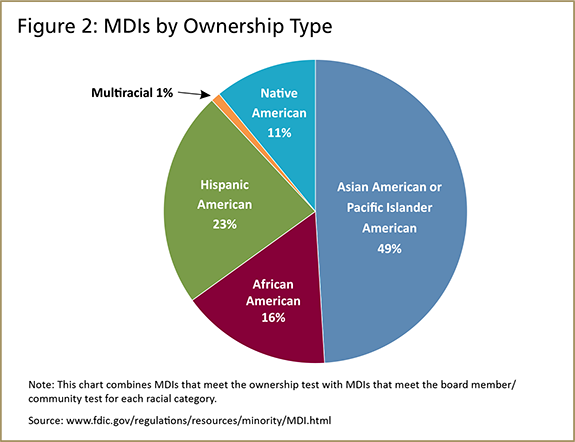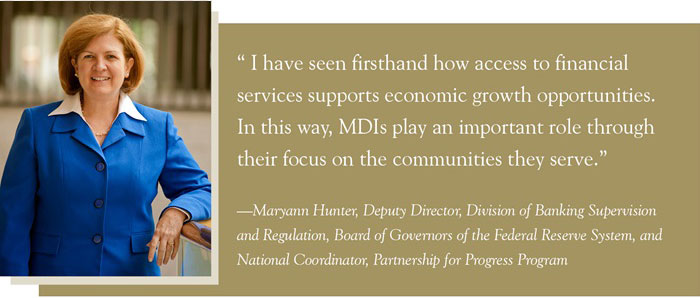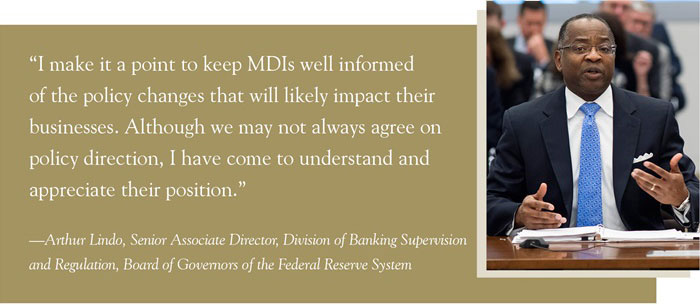Promoting an Inclusive Financial System: Spotlight on Minority Depository Institutions
by Erica Jill Tholmer, Supervisory Financial Analyst, Board of Governors of the Federal Reserve System, and H. Robert Tillman, Assistant Vice President, Supervision, Regulation and Credit, Federal Reserve Bank of Philadelphia
The Federal Reserve has a long history of fostering and supporting minority depository institutions (MDIs) because these banks play an important role in the U.S. financial system by providing banking services and extending credit to communities in underserved areas. The goals of this article are to bring attention to the legal foundation for supporting MDIs, discuss the key characteristics of MDIs, and explore some federal resources that are available to MDIs.
Background on MDIs
An MDI is defined by law as any depository institution whereby one or more socially and economically disadvantaged individuals owns 51 percent or more of the bank’s voting stock or a depository institution in which the board of directors, account holder base, or community served is composed mostly of minorities.1 As of June 30, 2014, there were 174 MDIs in the United States, 17 of which were state member banks supervised by the Federal Reserve.
Section 308 of the Financial Institutions Reform, Recovery, and Enforcement Act of 1989 (FIRREA), as amended by the Dodd-Frank Wall Street Reform and Consumer Protection Act (Dodd-Frank),2 requires the secretary of the Treasury to consult with the Chair of the Board of Governors of the Federal Reserve System, the Office of the Comptroller of the Currency (OCC), the chair of the National Credit Union Administration, and the chair of the board of directors of the Federal Deposit Insurance Corporation (FDIC) on the best methods of achieving the following goals:
- Preserving the present number of MDIs
- Preserving the character of MDIs in cases involving mergers or acquisitions
- Providing technical assistance to prevent insolvency
- Promoting and encouraging the creation of MDIs
- Providing for training, technical assistance, and educational programs
Each of these federal banking agencies has established a program to promote the sustainability of MDIs. Information on each agency’s program, including the Federal Reserve’s Partnership for Progress (PFP) program, is available on the agencies’ respective websites. Under Dodd-Frank, these agencies are also required to submit to Congress an annual report describing their efforts to meet the goals set forth in section 308 of FIRREA.
Characteristics of MDIs
Like most community banks, MDIs are a diverse group of institutions that vary by size, complexity, and location. Most are small community banks with total assets of less than $500 million (Figure 1).3 The asset size distribution of MDIs is consistent with the asset size distribution for all community banks.

Most MDIs are headquartered in major metropolitan areas, with a concentration in the most populous states: California, Texas, New York, and Florida.4 MDIs also vary by minority ownership, with the largest percentage under Asian American ownership (Figure 2).

Like many traditional community banks, MDIs face difficulty accessing capital markets and competition from larger banks. In the aftermath of the most recent financial crisis, despite moderate improvements in earnings and capital levels, MDIs continue to struggle with compressed net interest margins. In many cases, compounding MDI challenges are the effects of economic hardships on MDI customers, many of whom reside in low- or moderate-income (LMI) communities.5
The Mission of MDIs
Many MDIs follow a mission to help communities that are challenged with demographic and economic weaknesses and in which options for accessing traditional banking services tend to be limited. In other cases, MDIs were formed to address discriminatory banking practices and to provide credit to groups of people who historically were denied credit. In carrying out their mission, these banks help to reduce the number of underbanked customers and provide banking services that may otherwise go unmet.
In addition to loan products for LMI residents, some recent examples of services provided by MDIs include the following:
- An MDI in one Federal Reserve District provides auto loans to migrant farm workers.
- Several MDIs under Native American ownership support businesses on local reservations. Because these banks have deep local knowledge and ties to the Native American communities in which they operate, they may be more willing to look beyond traditional credit factors and underwrite more loans than other banks may be willing to do. For example, banks under Native American ownership may better understand the issues that surround loans in which the property held for collateral is in state trusts, which can make property seizure difficult in the event of default.6
Federal Reserve Resources
Partnership for Progress Program
In 2013, the Federal Reserve reaffirmed its commitment to MDIs in Supervision and Regulation (SR) letter 13-15/Consumer Affairs (CA) letter 13-11, “Federal Reserve Resources for Minority Depository Institutions.”7 This letter also discusses technical assistance that is available to MDIs through the Federal Reserve’s PFP program, a national outreach effort to help MDIs confront unique business model challenges, cultivate safe banking practices, and compete more effectively in the marketplace.
PFP Website. The PFP website8 provides relevant and timely information of interest to MDIs, including:
- Educational materials (for example, the online Bank Life Cycle curriculum provides content on the three phases of bank development: (1) starting a bank, (2) managing transitions, and (3) growing shareholder value)
- Information on new regulations and their impact on MDIs
- Announcements of regulatory and agency events relevant to MDIs
- Articles focused on market conditions and economic data related to LMI areas
PFP Leadership. The PFP program benefits from strong Federal Reserve coordination at the local and national levels. Maryann Hunter, deputy director of the Federal Reserve Board’s Division of Banking Supervision and Regulation (BS&R), serves as the national coordinator of the program.9 Staff members from both the Federal Reserve Board’s Division of BS&R and the Division of Consumer and Community Affairs (DCCA) are responsible for program implementation. Further, an Executive Oversight Committee, comprising senior officials from both the Board and the Federal Reserve Bank of Philadelphia, meets regularly to discuss progress toward program objectives set for each calendar year.

PFP District Coordinators. Each Reserve Bank has a PFP coordinator to oversee the program for the MDIs located in its District. State member banks with questions about the PFP program should direct their inquiries to the coordinator in their Federal Reserve District, as listed on the PFP website under “Contact Us.”10
Division of Banking Supervision and Regulation
Staff members in the Federal Reserve Board’s Division of BS&R provide technical assistance to MDIs to help these banks maintain safe and sound banking practices, primarily as they relate to the CAMELS rating components.11 They also prepare presentations to explain the effect of new capital and regulatory accounting policies on banks. In addition, BS&R staff members attend industry conferences to discuss trends in the state member MDI portfolio and to provide guidance on emerging safety and soundness risks.
Division of Consumer and Community Affairs
Federal Reserve Board DCCA staff members support community development opportunities for MDIs. The DCCA’s community development function sponsors initiatives aimed at increasing access to capital and financial services, promoting investment opportunities, and conducting applied research. These initiatives are especially important because, just as many households and communities suffered financially from the recent recession, so too did many community banks and MDIs that serve these communities.12
The DCCA is also instrumental in identifying opportunities for non-minority-owned banks to collaborate with MDIs. For example, non-minority-owned banks can receive consideration in their Community Reinvestment Act evaluations for collaborating with MDIs if the bank’s activities help meet the credit needs of the MDI’s local community, even if the activities are not within the non-minority-owned bank’s assessment area.13 Additional opportunities to collaborate with an MDI include making a deposit at, or capital investment in, an MDI; purchasing a loan participation from an MDI; or providing technical expertise to an MDI.
Community Depository Institutions Advisory Council
Each of the 12 Federal Reserve Banks has a local Community Depository Institutions Advisory Council (CDIAC) that meets regularly to discuss and share perspectives on matters relating to banking conditions. Several MDI bankers currently serve, or have served, on their local CDIAC. This council continues to be an important way for MDIs to communicate with the Federal Reserve on matters related to banking conditions and supervisory issues.
Other Resources Available to MDIs
Many opportunities exist for MDIs to build partnerships with the bank’s primary federal regulator as well as with a number of other government agencies.
Biennial Interagency Meeting
In addition to each agency’s efforts to support MDIs, the Federal Reserve, the OCC, and the FDIC jointly host a biennial interagency MDI conference. During these conferences, MDIs, as well as community development financial institutions (CDFIs) and representative trade groups, meet with staff members from each of the federal banking agencies along with leaders from other governmental and private agencies, to discuss regulatory hot topics, to consider collaboration opportunities, and to share perspectives on matters relevant to bank operations. The next interagency meeting will occur in July 2015.
Minority Bank Deposit Program
Through the U.S. Treasury Department’s Minority Bank Deposit Program, the Bureau of the Fiscal Service distributes a list of certified MDIs to federal agencies, state and local government agencies, and private-sector enterprises to encourage these entities to establish banking services with certified MDIs.14
CDFI Fund
Nearly 40 percent of MDIs are also certified CDFIs, which are financial institutions that provide services to areas that lack access to traditional financial institutions. To support economic growth in underserved and financially disadvantaged communities, the U.S. Treasury Department’s CDFI Fund invests in CDFIs and provides incentives for banks to invest in CDFIs and their communities.15

Summary
The Federal Reserve recognizes the importance of MDIs and their role in the national economy. The Federal Reserve’s support for MDIs throughout the years demonstrates that even if it were not for the requirements of FIRREA, the work of MDIs is worthy of focus because of their contribution to the viability of local economies and their support of underbanked customers.
Back to top
- 1 In regard to MDIs, minority is defined in the statute as any black American, Native American, Hispanic American, or Asian American.
-
2
See Title III, section 367(4), 12 U.S.C. section 1463 (2001 & Supp. 2013), available at http://ow.ly/EsGu5.

- 3 The Federal Reserve generally defines community banking organizations as those organizations with less than $10 billion in total assets.
-
4
See FDIC, “Minority Depository Institutions: Structure, Performance, and Social Impact,” FDIC Quarterly, Second Quarter 2014, available at http://ow.ly/EsKKn.

-
5
See “Minority Depository Institutions: Structure, Performance, and Social Impact,” available at http://ow.ly/EsKKn.

-
6
See “Native American Bank: Banking the Unbanked,” Communities & Banking, vol. 17 (Summer 2008), Federal Reserve Bank of Boston, available at http://ow.ly/EsXAK.

-
7
SR letter 13-15/CA letter 13-11, “Federal Reserve Resources for Minority Depository Institutions,” is available at www.federalreserve.gov/bankinforeg/srletters/sr1315.htm.

-
8
Visit the PFP website at http://fedpartnership.gov/
 for more information.
for more information.
- 9 See Maryann Hunter, “Board Staff Perspective on Community Bank Supervision: One Size Doesn’t Fit All,” Community Banking Connections, Second Quarter 2014, available at www.cbcfrs.org/articles/2014/Q2/view-from-washington.
-
10
A list of Reserve Bank PFP coordinators is available at www.fedpartnership.gov/contacts/.

-
11
CAMELS ratings address the adequacy and quality of a depository institution’s capital, asset quality, management, earnings, liquidity, and sensitivity to
market risk. See SR letter 96-38, “Uniform Financial Institutions Rating System,” available at www.federalreserve.gov/boarddocs/srletters/1996/sr9638.htm.

-
12
Those interested in learning more about the Federal Reserve’s efforts to advance community development are encouraged to visit the DCCA’s community
development website at www.fedcommunities.org/.

- 13 See 2 U.S.C. section 2903(b) and 12 CFR section 228.21(f).
-
14
See the Bureau of the Fiscal Service’s website for details at www.fms.treas.gov/mbdp/index.html.

-
15
For more information, see the Department of the Treasury’s CDFI Fund website at www.cdfifund.gov/who_we_are/about_us.asp.

